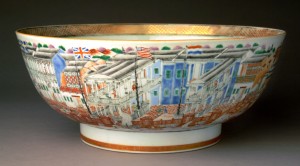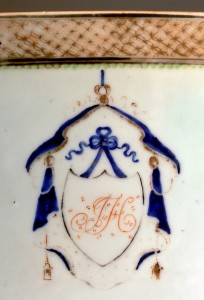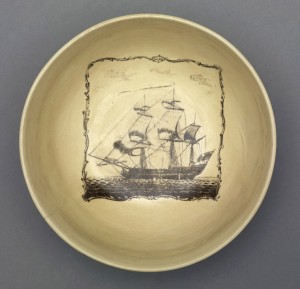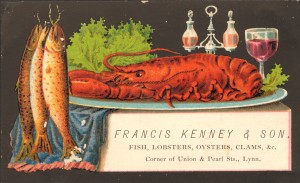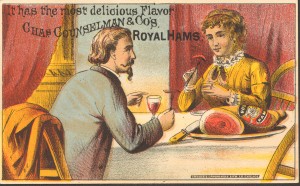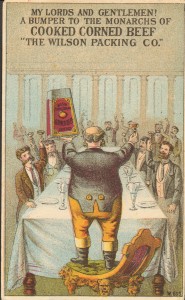When inscribed, many 18th-century wine vessels in ceramics, glass, metalwork or other materials bore phrases or motifs in honor of Trade. Punch bowls, especially, might bear painted or printed views of ships over generic phrases such as “Success to Trade” or more individualized ones wishing well to a particular ship, ship’s captain, or ship owner.
As is sometimes true today, new ventures were sometimes celebrated with a glass of wine. Increasingly during the 1800s, advertisements for a broad range of wares include wineglasses raised in toasts or placed on elegantly fitted out dinner tables.
“Hong” punch bowl
Jingdezhen, China; 1785–88
Porcelain (hard paste)
Gift of Joseph D. and Janet M. Shein 2005.37
The warehouses and residences of European merchants in Canton, China, were called “hongs,” and bowls decorated with scenes of those buildings are called “hong bowls.” Those made after 1785 bear the U.S. flag, recognizing the start of this country’s direct trade with China. The important bowl here was passed down in the family of the original owner, Isaac Hendrickson, a prominent shipping merchant and government official in Wilmington, Delaware, during the late 1700s and early 1800s. Hendrickson was an active member of a local society established for the “gradual Abolition of Slavery” and was also a Quaker. Objects such as this punch bowl illustrate the fact that although Quakers believed in moderation, not all believed in abstinence from alcohol.
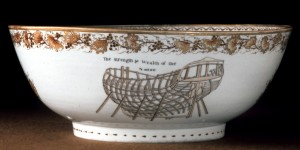 Punch bowl
Punch bowl
Jingdezhen, China; 1800–1815
Porcelain
Inscribed “The strength and wealth of the Nanon” and “E PLUPIE UNUUM”
Museum purchase 1957.63
There is a long tradition of ceramic “ship bowls” being produced to celebrate trading or military ventures. Many bear owner’s names, dates, and inscriptions. The Chinese porcelain bowl here portrays a ship under construction and was presumably made for a merchant or ship owner. The patriotic phrase is thought to have been intended to read as “The strength and wealth of the Nation.” The U.S. seal on the reverse of the bowl reflects the owner’s pride in America.
Punch bowl
John Sadler or John Sadler and Guy Green, Liverpool, England (printed images); Staffordshire, England (bowl); 1760–75
Earthenware (creamware)
Bequest of Henry Francis du Pont 1961.932
The English creamware bowl would have been more affordable and may have cashed in on the craze 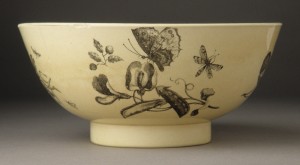 for ship bowls in nearly all refined ceramic materials. In this case, a square, printed view of a sailing ship—originally intended for use on delft wall tiles or fireplace tiles—has been applied to the interior of the bowl.
for ship bowls in nearly all refined ceramic materials. In this case, a square, printed view of a sailing ship—originally intended for use on delft wall tiles or fireplace tiles—has been applied to the interior of the bowl.
Trade card for Francis Kenney and Son
Probably Lynn, Massachusetts; about 1880
Inscribed “FRANCIS KENNEY & SON, / FISH, LOBSTERS, OYSTERS, CLAMS, &c. / Corner of Union & Pearl Sts., Lynn.”
Joseph Downs Collection of Manuscripts and Printed Ephemera, Winterthur Library Col. 9 68×164.223
Trade card for Charles Counselman and Company
Shober (?) & L’Aroueville
Probably Chicago, Illinois; about 1880
Inscribed “It has the most delicious Flavor / CHAS. COUNSELMAN & CO’S. / ROYAL HAMS”
Joseph Downs Collection of Manuscripts and Printed Ephemera, Winterthur Library Col. 9 68×164.212
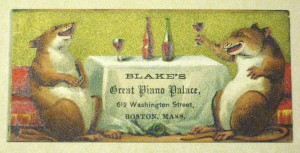 Trade card for piano merchant
Trade card for piano merchant
Boston, Massachusetts; about 1880
Inscribed “BLAKE’S /Great Piano Palace/612 Washington Street, /BOSTON, MASS.”
Joseph Downs Collection of Manuscripts and Printed Ephemera, Winterthur Library Col. 9 68×164.507
Trade card for Wilson Packing Company
Chicago, Illinois; about 1880
Inscribed “MY LORDS AND GENTLEMEN! / A BUMPER TO THE MONARCHS OF / COOKED CORNED BEEF / ‘THE WILSON PACKING CO.’”
Joseph Downs Collection of Manuscripts and Printed Ephemera, Winterthur Library Col. 9 68×164.245
On trade cards for merchants selling a variety of goods, a glass of wine could added a sense of elegance. In some cases—as we see here—enticing card designs were created with blank spaces for the addition of a merchant’s name, advertising slogan, or address.
Related Themes:

